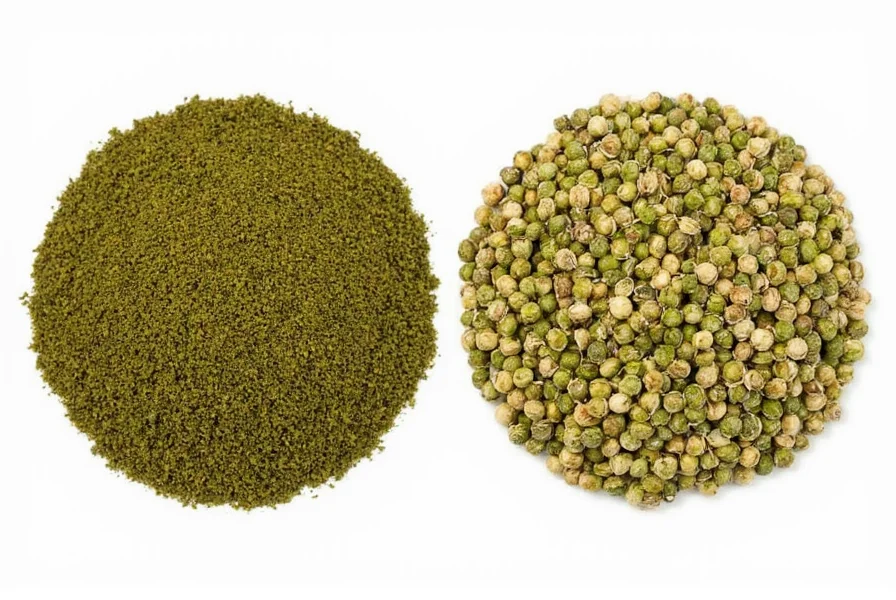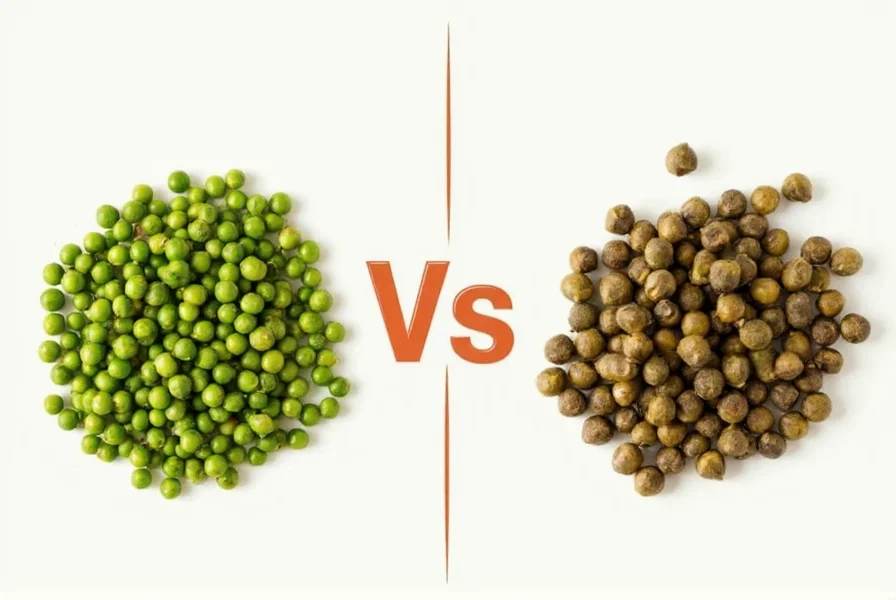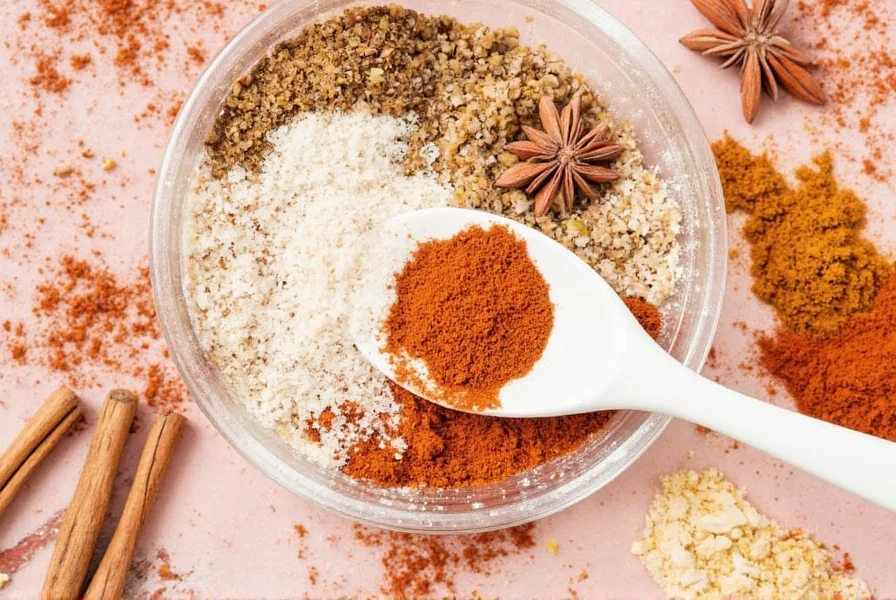Table of Contents
Introduction
Green peppercorns and capers are both popular flavor enhancers but originate from entirely different plants and serve distinct culinary purposes. Green peppercorns are unripe berries of the black pepper plant with a mild citrusy taste, while capers are pickled flower buds offering a sharp, briny punch. This guide provides expert insights on their differences, precise usage techniques, and professional substitution tips to elevate your cooking.

What Are Green Peppercorns?
Green peppercorns are the unripe berries of the black pepper plant (Piper nigrum). Harvested before full ripening, they're preserved in brine or vinegar to retain their fresh, citrusy profile. Unlike black peppercorns (which undergo fermentation), green peppercorns deliver a subtle, slightly sweet flavor with minimal heat, making them ideal for delicate dishes where a bright pepper note is needed without overwhelming other ingredients.
What Are Capers?
Capers are the pickled flower buds of the Capparis spinosa shrub, native to the Mediterranean. These tiny, spherical buds are cured in salt or brine, developing a pronounced salty-tangy character. They're distinct from caper berries (the mature fruit), which have a milder taste. Capers are essential in Mediterranean cuisine for adding complexity to sauces, dressings, and seafood dishes.
| Feature | Green Peppercorns | Capers |
|---|---|---|
| Origin | Unripe berries of Piper nigrum | Flower buds of Capparis spinosa |
| Flavor Profile | Mild, citrusy, slightly sweet, low heat | Briny, tangy, salty, sharp |
| Texture | Soft, juicy, tender | Firm, crunchy, chewy |
| Best Cooking Application | Added at the end of cooking; ideal for cream sauces, seafood, poultry | Added early for infusion; perfect for pasta, fish, salad dressings |
| Common Substitutes | Black pepper (finely ground), pink peppercorns | Chopped green olives, pickled green beans |
| Price Range (per 4oz jar) | $5-$10 | $3-$8 |
| Shelf Life | 1 year refrigerated in brine | 1-2 years in cool, dark place |

Culinary Uses
Green peppercorns and capers excel in different culinary contexts due to their distinct profiles:
Green Peppercorns
- Steak au Poivre: Crush lightly and coat steaks before searing for a sophisticated pepper crust
- Creamy Sauces: Add to béarnaise or mushroom sauces for bright, non-pungent depth
- Seafood: Perfect for poached salmon or shrimp scampi where delicate flavor won't overpower
- Marinades: Use in vinaigrettes for chicken or vegetable dishes to add subtle citrus notes
Capers
- Pasta: Essential in puttanesca sauce; toss with spaghetti, tomatoes, and anchovies
- Fish Dishes: Add to lemon-butter sauces for cod or halibut to enhance umami
- Salads: Mix into Nicoise or potato salads for salty tang
- Spread Enhancer: Blend into cream cheese or hummus for instant flavor complexity
Buying Guide
Green Peppercorns
- Quality Indicators: Look for plump, green berries in brine (avoid shriveled or discolored ones)
- Brine vs. Vinegar: Brine-preserved offers milder flavor; vinegar-preserved has sharper tang
- Top Brands: Penzeys, Spice House, and Frontier Co-op offer consistent quality
- Where to Buy: Specialty spice shops, gourmet grocery stores, or online retailers
Capers
- Size Matters: Non-pareil (smallest, most delicate) are premium; caper berries are larger and milder
- Salt-Packed vs. Brine-Packed: Salt-packed needs rinsing; brine-packed is ready to use
- Top Brands: Colavita, Berio, and Mezzetta provide reliable quality
- Where to Buy: Italian markets, major supermarkets (near olives), or online
Practical Tips
- Storage: Keep both submerged in liquid; refrigerate after opening. Green peppercorns last 1 year; capers 1-2 years
- Rinsing: Always rinse capers (especially salt-packed) to control saltiness. Green peppercorns rarely need rinsing
- Substitution: For green peppercorns: use black pepper (1:2 ratio) but add at the end. For capers: green olives (1:1) work for texture but not flavor
- Professional Tip: Toast green peppercorns lightly in a dry pan before crushing to intensify aroma without burning
Frequently Asked Questions
- Can green peppercorns be substituted for capers?
- No, they're fundamentally different ingredients. Green peppercorns come from pepper plants with citrusy notes, while capers are pickled flower buds with intense saltiness. Substituting would drastically alter dish flavor profiles.
- Are green peppercorns just unripe black peppercorns?
- Yes, but processing differs: black peppercorns are dried and fermented for sharp heat, while green peppercorns are preserved fresh in brine/vinegar to maintain mild, citrusy characteristics.
- Why are capers so expensive?
- Capers require hand-harvesting during brief morning windows when buds are at peak quality. This labor-intensive process, combined with pickling preservation, makes them costly compared to other spices.
- How should I store green peppercorns and capers?
- Store both in their original liquid. Green peppercorns: refrigerate in brine for up to 1 year. Capers: keep in brine in cool, dark place; refrigerate after opening. Ensure they're fully submerged to prevent spoilage.
- Do I need to rinse capers before using them?
- Yes, rinse salt-packed capers thoroughly to reduce saltiness. For brine-packed, a quick rinse helps control salt levels unless the recipe specifically calls for intense briny flavor.
- What dishes work best with green peppercorns?
- They shine in delicate applications: cream sauces (e.g., steak au poivre), seafood dishes, poultry marinades, and light vinaigrettes where subtle citrus pepper notes enhance without overpowering.
- Can I eat green peppercorns and capers straight from the jar?
- Technically yes, but they're intended as flavor enhancers. Green peppercorns are milder but still strong alone; capers are intensely salty and should always be used sparingly in cooking.
- What's the difference between capers and caper berries?
- Capers are unopened flower buds (small, intense flavor), while caper berries are the mature fruit (larger, milder taste with seeds). Caper berries are often pickled whole and used as garnishes.
- Where can I find the best quality green peppercorns?
- Specialty spice retailers like Penzeys or online gourmet stores offer the highest quality. Look for plump, vibrant green berries in brine—avoid discolored or shriveled options.
Conclusion
Green peppercorns and capers serve distinct roles in the kitchen despite superficial similarities. Green peppercorns provide delicate citrusy brightness for subtle enhancements, while capers deliver bold briny complexity to elevate savory dishes. Understanding their unique characteristics—origin, flavor profiles, and optimal usage—allows you to choose the right ingredient for each recipe, transforming ordinary meals into gourmet experiences. Experiment with these ingredients to unlock new dimensions of flavor in your cooking.











 浙公网安备
33010002000092号
浙公网安备
33010002000092号 浙B2-20120091-4
浙B2-20120091-4